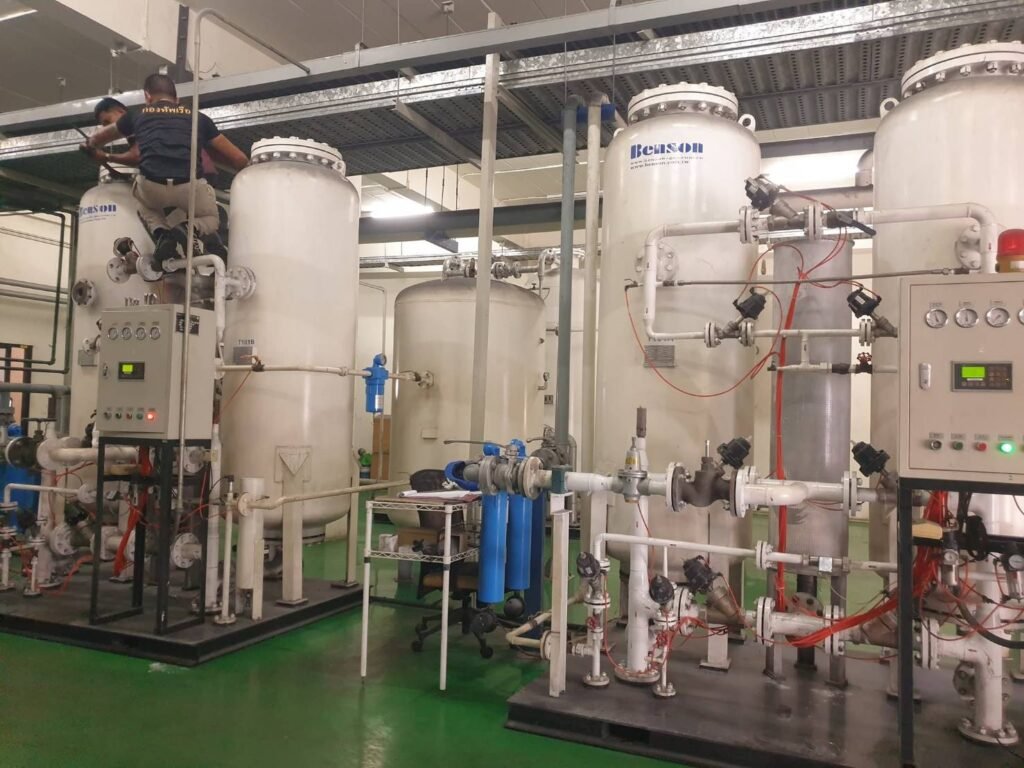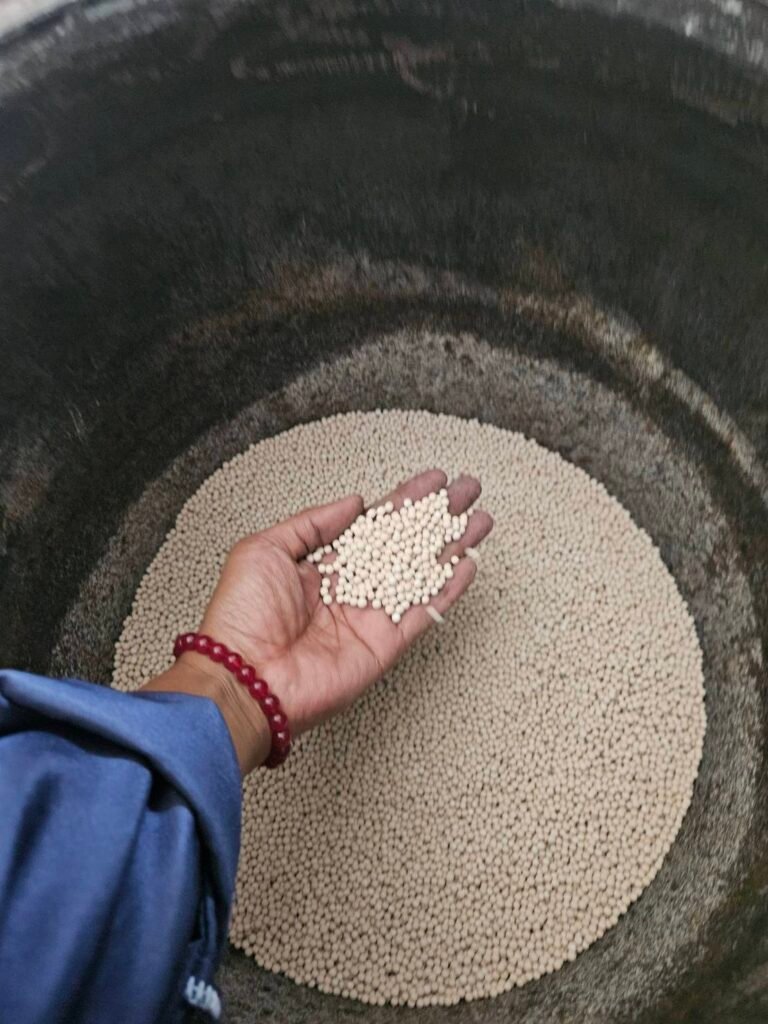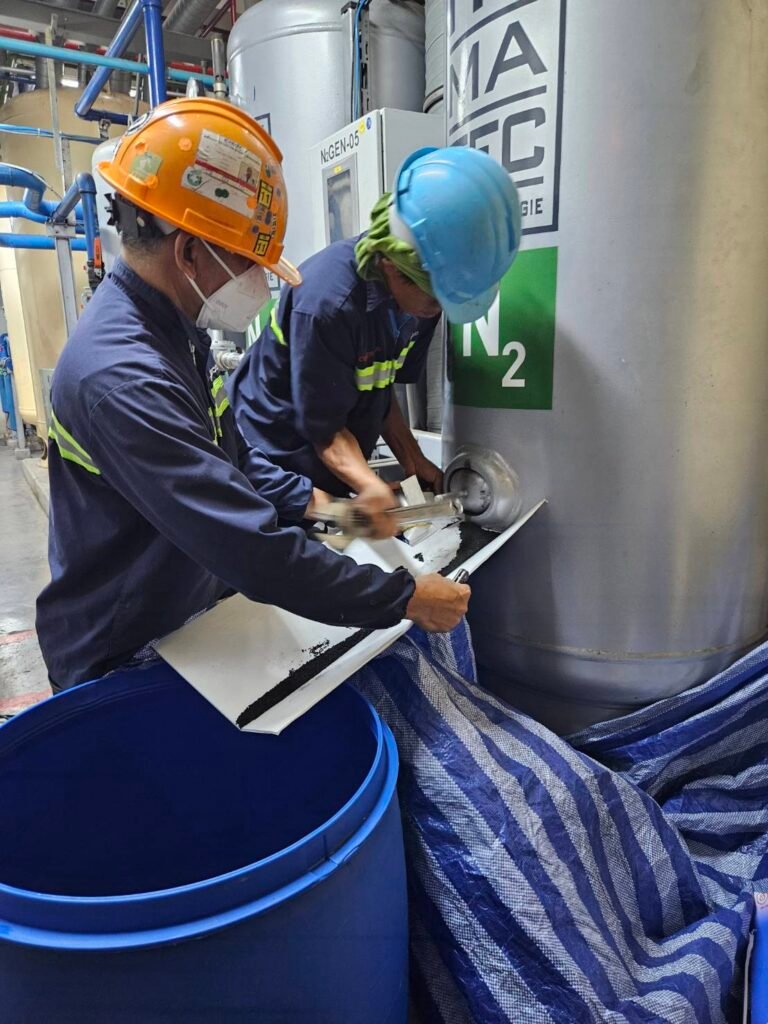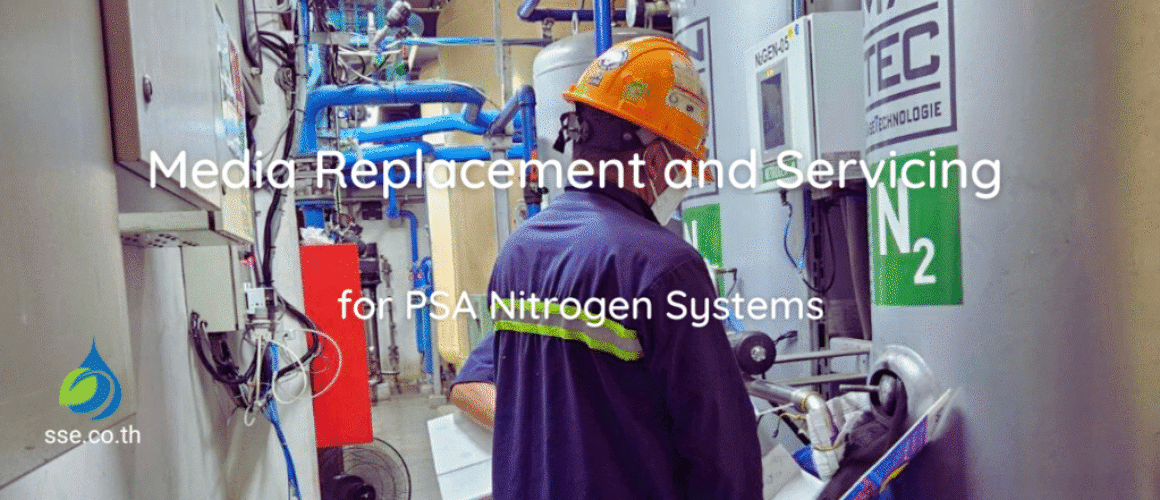Media Replacement and Servicing for PSA Nitrogen Systems


| Topic | Insight |
|---|---|
| Focus | PSA Nitrogen Generator Media Replacement and Servicing |
| Core Media | Molecular sieves (3A, 4A, 5A) and activated carbon filters |
| Primary Functions | Molecular sieves remove oxygen, CO₂, and moisture; activated carbon removes oil vapors and hydrocarbons |
| Service Interval | Typically every 2–3 years depending on inlet air quality and regeneration conditions |
| Common Issues | Declining nitrogen purity, pressure drop, high dew point, oil contamination |
| SSE Expertise | On-site inspection, media testing, and complete replacement services |
| Outcome | Restored nitrogen purity (up to 99.9%) and extended adsorbent service life |
Table of Content
“A well-maintained molecular sieve doesn’t just separate gases—it defines the reliability of your nitrogen supply.”
Introduction – Keeping Nitrogen Flowing Smoothly
PSA Nitrogen Generator Media Replacement and Servicing is something I’ve come to view as both an art and a science. When a PSA nitrogen generator begins losing purity or pressure, the culprit often isn’t the machine itself—it’s the media inside it. Those tiny pellets and beads do all the hard work, quietly capturing contaminants and ensuring consistent nitrogen purity.
| Aspect | Description | Typical Values / Notes |
|---|---|---|
| Process Name | Pressure Swing Adsorption (PSA) | Separates gases by adsorption and desorption under pressure changes |
| Key Media | Molecular Sieve (3A, 4A, 5A) and Activated Carbon | Responsible for oxygen, moisture, and oil vapor removal |
| Target Gas Purity | Nitrogen (N₂) ≥ 99.9% | Dependent on inlet air quality and cycle control |
| Operating Pressure | 6–8 bar | Standard for industrial PSA units |
| Media Replacement Interval | 2–3 years | Based on temperature, inlet quality, and regeneration efficiency |
| Primary Maintenance Goal | Maintain nitrogen purity, prevent contamination, and extend adsorbent service life |
Over the years, I’ve seen this firsthand. During one of our recent service projects at a food packaging facility in Chachoengsao, the plant’s nitrogen purity had dropped from 93% to just under 90%. After replacing the activated carbon and molecular sieves, the purity shot back to 99.5% within hours. It’s a perfect reminder that even the best PSA units rely on clean, active media to perform efficiently.
In this article, I’ll explain how molecular sieves (3A, 4A, 5A) and activated carbon filters work together to keep PSA nitrogen generators running efficiently, how to know when it’s time for desiccant replacement, and what best practices ensure long media life.
Understanding PSA Technology – The Role of Adsorption
At the core of every PSA nitrogen generator lies the adsorption process—a simple yet powerful principle. PSA stands for Pressure Swing Adsorption, and it works by separating gases based on how strongly each component adheres to an adsorbent surface. Unlike absorption, where a gas dissolves into a liquid or solid, adsorption happens at the surface level.
| Property | Adsorption | Absorption |
|---|---|---|
| Process Type | Surface-based | Volume-based |
| Interaction | Gas molecules adhere to solid surface | Gas dissolves into another medium |
| Reversibility | Easily regenerated | Usually irreversible |
| Example | Oxygen captured by molecular sieve | CO₂ dissolving in water |
| Relevance in PSA | Core separation mechanism | Not applicable |
In a PSA nitrogen generator, compressed air passes through two adsorption towers filled with molecular sieve material. These tiny crystalline beads have pores precisely sized to trap smaller gas molecules like oxygen, carbon dioxide, and moisture, while allowing nitrogen to pass through.


Each tower alternates between adsorption and regeneration cycles. When one bed is actively adsorbing impurities, the other is depressurized and purged, releasing trapped gases and restoring its capacity. This cyclical design allows the system to produce nitrogen continuously, maintaining steady flow and purity.
The performance depends on a few key parameters—adsorption capacity (typically 22–26% H₂O by weight), pore size (3A, 4A, or 5A), and temperature (most sieves operate optimally below 60°C). Understanding these basics helps any operator recognize how critical media condition is to the process.
Molecular Sieves – Precision in Gas Separation
Molecular sieves are the unsung heroes of nitrogen generation—microscopic aluminosilicate crystals engineered with pores so uniform they can differentiate between molecules by size. These materials are part of the zeolite family, and they’re classified by pore diameter:
- 3A molecular sieve: ideal for removing moisture from hydrocarbons.
- 4A molecular sieve: commonly used for air drying and CO₂ removal.
- 5A molecular sieve: the workhorse for oxygen separation in PSA nitrogen generators.
When compressed air enters the PSA system, these sieves trap oxygen, water vapor, and carbon dioxide molecules within their pores, leaving nitrogen as the purified product.
| Type | Pore Size (Å) | Main Function | Static H₂O Adsorption (%) | Typical Use |
|---|---|---|---|---|
| 3A | 3 | Removes water from hydrocarbons | 20–21 | Drying of polar gases and liquids |
| 4A | 4 | Removes CO₂ and H₂O from air | 22–23 | Air drying and CO₂ removal |
| 5A | 5 | Removes oxygen, CO₂, and moisture | 24–26 | PSA nitrogen and hydrogen purification |
A high-quality molecular sieve typically has a static water adsorption capacity of 21–22% by weight, crush strength of 80–100 N/bead, and a bulk density around 0.75 g/cm³. These metrics define how durable and efficient the material is under cycling conditions.


In practice, molecular sieves last about two to three years, depending on inlet air quality and operating temperature. Over time, exposure to oil vapor, excessive moisture, or thermal stress causes pore blockage and dust formation. During one service visit to a steel fabrication plant, we opened a three-year-old PSA unit and found the sieves turned dull gray, brittle, and powdery—a classic case of oil contamination and overuse.
That’s why PSA nitrogen generator media replacement and servicing is so essential. Restoring fresh sieves resets the system’s adsorption performance and prevents downstream contamination.
Activated Carbon – The First Line of Defense
Before compressed air ever reaches the molecular sieves, it first passes through an activated carbon filter—the silent guardian that captures oil vapor, hydrocarbons, and odors. This is not just a prefilter; it’s a protective barrier that ensures the molecular sieve beds aren’t poisoned by oil aerosols.


| Property | Specification | Purpose |
|---|---|---|
| Material | Coconut-shell based | High micropore volume and hardness |
| Form | Extruded pellets (3–4 mm) | Low pressure drop, high mechanical strength |
| Iodine Number | 1000–1050 mg/g | Measures adsorption activity |
| Bulk Density | 0.45–0.55 g/mL | Determines bed mass and flow resistance |
| Moisture Content | ≤5% | Ensures stability during operation |
| Ash Content | ≤3% | Low mineral residue prevents contamination |
| Service Life | 12–24 months | Depends on oil vapor concentration |
Activated carbon works through physical adsorption. Its labyrinth of micropores, often exceeding 1000 m² of surface area per gram, attracts organic molecules and traps them through van der Waals forces. The process is simple yet powerful: every cubic centimeter of carbon provides millions of adsorption sites.
In most PSA systems, extruded activated carbon pellets (3–4 mm diameter) are preferred for gas-phase filtration. Typical specifications include an iodine number of 1000–1050 mg/g, bulk density around 0.45–0.55 g/mL, and moisture content below 5%. These properties ensure strong adsorption and easy handling.
When we replaced the activated carbon filter at an electronics plant in Rayong, the spent pellets were sticky and emitted a faint oil smell—clear evidence of saturation. After refilling with fresh PureSorb GB-100E from SSE, the air purity improved immediately, and the downstream sieve life was extended by months.
Activated carbon filters typically last 12–24 months, depending on oil vapor levels and temperature. Regular inspection and replacement are critical to prevent costly downtime.
For further reading on adsorption performance in carbon media, refer to the cornerstone page PureSorb GB-100E: The Ideal Solution for Gas Adsorption and Air Purification and our technical comparison article Comparing CO₂ Adsorption and N₂ Adsorption on Activated Carbon, Alumina, and Zeolites: Insights for Carbon Capture and Gas Purification.
When and How to Replace the Media
Even the best adsorbents eventually reach their limit—the key is knowing when to act before nitrogen purity starts slipping. PSA nitrogen generators give warning signs long before failure, and recognizing them saves both time and money.
The most common symptoms include:
- A gradual drop in nitrogen purity
- Shorter cycle times and uneven pressure equalization
- Rising dew point readings
- Visible dusting or fines in outlet filters
When these signs appear, it’s time for PSA nitrogen generator media replacement and servicing. The process involves several methodical steps:
- Depressurize and isolate the vessel.
- Open the access ports carefully.
- Remove the spent media using vacuum or manual tools.
- Clean the vessel interior and check for corrosion.
- Replace support layers (felt pads, diffusers, stainless mesh).
- Load fresh activated carbon and molecular sieve in the correct sequence.
- Seal, pressure test, and restart the unit.
During a recent service at a nitrogen system using 3.2×3.2×1.2 m vessels, we refilled around 4 tons of activated carbon, equivalent to 160 bags of 25 kg each. The new carbon had a density of 0.47 g/mL, providing optimal bed height and backpressure balance. After reassembly, the unit’s nitrogen purity stabilized at 99.9%—a perfect demonstration of how proper media replacement restores system performance.
Best Practices for Longer Service Life
Proper maintenance can easily double the life of your adsorption media—and save thousands in nitrogen production costs. The key lies in proactive PSA nitrogen system maintenance and high-quality air purification media.
Here are some best practices we follow in the field:
- Keep inlet air clean and dry. Limit oil to below 1 ppm, maintain air temperature under 40°C, and use prefilters for dust and aerosols.
- Monitor dew point sensors monthly; deviations indicate adsorbent degradation or regeneration inefficiency.
- Backflush and inspect valves to ensure balanced switching between towers.
- Drain condensate traps daily to prevent water carryover.
- Train operators to identify early warning signs like odor, pressure drop, or sudden purity changes.
During servicing, always verify regeneration gas flow and temperature. Excess heat can damage zeolite structure, while insufficient purging leaves residual moisture. Balanced operation preserves both adsorption capacity and mechanical integrity, extending adsorbent service life well beyond the expected two-year mark.
For those seeking reliable replacements, SSE offers the full line of PureSorb products, including PureSorb WB100 for Water Purification and Organic Contaminant Removal and our professional Media Replacement and Servicing Program.
Why Regular Servicing Matters
Neglecting PSA nitrogen generator media replacement and servicing leads to more than just lower purity—it can compromise your entire system. Clogged sieve beds increase backpressure, causing higher energy consumption and uneven regeneration. Contaminated carbon filters release hydrocarbons that permanently deactivate the sieves.
From experience, I’ve seen what happens when maintenance schedules are ignored. A client in a steel fabrication plant delayed replacement by six months; when the system finally failed, both towers had to be stripped and rebuilt, doubling their cost and downtime. Timely servicing would have prevented it entirely.
Media health directly affects nitrogen purity, adsorbent service life, and long-term equipment reliability. Think of it like changing the oil in your car—cheap insurance against expensive repairs.
For deeper insight into adsorption kinetics and CO₂ capture efficiency on carbon media, the ACS publication Activated Carbon as an Adsorbent for CO₂ Capture: Adsorption, Kinetics, and RSM Modeling provides valuable scientific context supporting industrial applications.
Human Side of Field Servicing
Every servicing job tells a story. Standing inside a noisy compressor room, tools in hand, surrounded by stainless steel vessels—it’s not glamorous work, but it’s deeply satisfying. Watching the nitrogen purity monitor climb back toward 99% after a full media change reminds you why attention to detail matters.
Our team has worked on units from NANOMATEC, Benson, and other major OEMs. The process is always similar: open, inspect, clean, and refill. But each site brings unique challenges—tight spaces, hot weather, or contaminated systems. What keeps it rewarding is knowing that a well-executed desiccant replacement directly supports critical industries—from electronics to pharmaceuticals—where pure nitrogen means product safety.
At SSE, we take pride not just in supplying adsorbents but in ensuring every client’s system runs smoothly. We’ve built our expertise on decades of hands-on experience and continuous testing under Thai industrial conditions.
“Activated carbon is the first line of defense—when it fails, the molecular sieve pays the price.”
Frequently Asked Questions
What is Media Replacement and Servicing for PSA Nitrogen Systems?
Media Replacement and Servicing for PSA Nitrogen Systems refers to the process of removing and replacing the adsorbent materials—primarily molecular sieves and activated carbon filters—that purify compressed air and produce high-purity nitrogen. Over time, these materials lose adsorption efficiency due to oil vapor, moisture, and CO₂ contamination. Replacing them restores optimal nitrogen purity and system performance.
How often should the media be replaced in a PSA nitrogen generator?
Typically, molecular sieve 5A in PSA systems lasts about 2–3 years, while activated carbon in the pre-treatment stage requires replacement every 12–24 months, depending on air quality. Regular PSA nitrogen system maintenance and proper air filtration extend this interval by minimizing oil vapor and moisture exposure.
What are the signs that my PSA nitrogen generator needs servicing?
Common indicators include:
A gradual drop in nitrogen purity
Increased dew point or moisture breakthrough
Shorter adsorption/regeneration cycle times
Excessive dusting from the sieve bed
A strong odor or oily residue near the activated carbon filter
If you observe these symptoms, it’s time to schedule desiccant replacement and inspection.
What is the function of molecular sieves in PSA nitrogen systems?
Molecular sieves (types 3A, 4A, and 5A) act as precision adsorbents that separate gases based on molecular size.
3A sieves remove moisture from hydrocarbons.
4A sieves remove CO₂ and H₂O from air.
5A sieves separate oxygen and other trace gases from nitrogen.
Their adsorption process relies on a network of uniform pores that trap unwanted molecules while letting nitrogen pass freely.
Why is the activated carbon filter so important in the PSA process?
The activated carbon filter is the first line of defense in any air purification media system. It captures oil vapors, hydrocarbons, and odors before they can reach and deactivate the molecular sieves. Without it, oil vapor removal efficiency drops, leading to permanent damage to the zeolite structure and reduced system lifespan. Replacing carbon regularly is essential for long-term industrial gas purification.
What happens during sieve bed regeneration?
During sieve bed regeneration, the pressure in the bed is reduced and part of the dry nitrogen gas is redirected backward through the bed to purge moisture, oxygen, and CO₂ from the molecular sieve. This regeneration cycle restores the adsorbent’s surface area and ensures continuous production. Proper timing and purge flow are critical to maintaining adsorbent service life.
How can I improve the service life of my adsorbents?
To extend adsorbent service life, maintain inlet air temperature below 40°C, use coalescing filters to remove oil and water, and inspect the activated carbon filter regularly. Keep the CO₂ and moisture adsorption load low by ensuring your air dryer and filters operate effectively. Clean, dry, and oil-free air dramatically increases the lifespan of your media.
What causes sudden drops in nitrogen purity?
Sudden purity loss is often caused by:
Saturated or contaminated molecular sieve media
Oil or water breakthrough from faulty prefilters
Incomplete sieve bed regeneration
Uneven tower cycling or valve malfunctions
A thorough nitrogen generator troubleshooting process should include checking the adsorption beds, valve timing, and purge settings.
What is the role of CO₂ and moisture adsorption in PSA nitrogen systems?
CO₂ and moisture are the two major impurities that affect nitrogen quality. In the adsorption process, molecular sieves trap both molecules within their pores during pressurization. This ensures the final nitrogen stream is dry (low dew point) and free of acidic contaminants that can corrode pipelines and downstream instruments.
Can I perform media replacement and servicing in-house, or should it be outsourced?
While minor PSA nitrogen system maintenance (like filter changes) can be handled in-house, full media replacement and servicing should be performed by trained professionals. It requires vessel depressurization, proper layering of adsorbents, and safety controls. Certified servicing ensures correct loading densities, prevents air leaks, and maintains design-level nitrogen purity for years to come.
Conclusion – Clean Media, Consistent Nitrogen
Behind every reliable PSA nitrogen generator is a well-maintained adsorption system—clean media means clean gas, every time. PSA Nitrogen Generator Media Replacement and Servicing isn’t just routine maintenance; it’s performance assurance.
The partnership between activated carbon and molecular sieves is what keeps nitrogen generators running efficiently: carbon protects the system from oil vapor and hydrocarbons, while sieves deliver precise separation of nitrogen from air. Together, they ensure purity, reliability, and energy efficiency.
At SSE Enterprise, we provide the complete package—premium PureSorb adsorbents, expert field servicing, and detailed performance monitoring. If you’re planning your next media changeout or want to optimize cycle performance, contact us or explore our Activated Carbon range for tailored solutions. See also our comprehensive guide to activated carbon.
Because in the end, the secret to reliable nitrogen isn’t the equipment—it’s the care you give the media inside.
Disclaimer
This article is provided for educational and informational purposes to assist engineers, operators, and technical managers in understanding PSA nitrogen generator operation and maintenance. Performance values and procedures may vary based on system design, environmental conditions, and manufacturer specifications. Always follow your equipment supplier’s safety and servicing guidelines.
ขอบคุณที่ใช้เวลาอ่านบทความของเราเกี่ยวกับการป้องกันความชื้น ทางเราหวังว่าท่านจะได้รับข้อมูลที่มีคุณค่าและเป็นประโยชน์ ทางเรายินดีให้บริการการปรึกษาฟรีเพื่อพูดคุยเกี่ยวกับความต้องการของท่านและให้คำแนะนำเกี่ยวกับวิธีการป้องกันความชื้นที่กำหนดเฉพาะสำหรับคุณ โปรดติดต่อเราที่ 0858124188 เพื่อนัดหมายการปรึกษาหรือเยี่ยมชมร้านค้าของเราเพื่อค้นหาผลิตภัณฑ์ที่ช่วยป้องกันสินค้าของคุณจากความเสียหายจากความชื้น ทางเราหวังว่าจะได้รับข่าวสารจากท่านเร็วๆนี้
